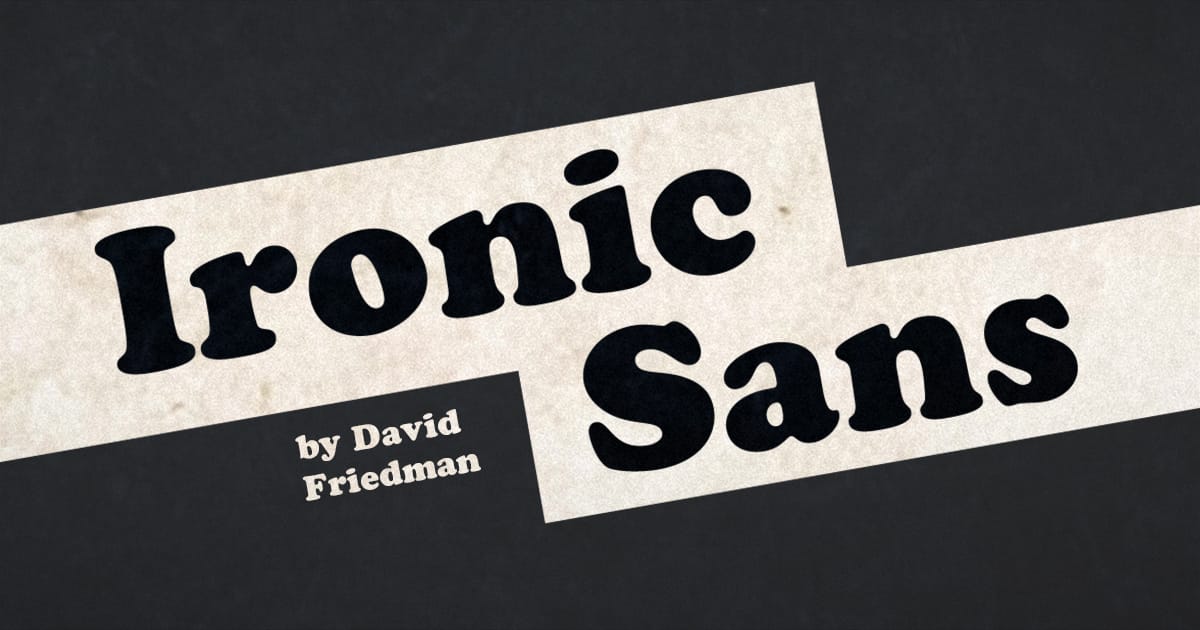It’s True: The JAWS Shark is Public Domain
A story with legal drama, a mystery, snow leopards, and, uh, naughty bits.

As we’re all celebrating the 50th anniversary of the movie Jaws, here’s something I bet you didn’t know: Due to a fluke of publishing and copyright law, the Jaws shark is public domain.
It’s not the character of the shark that’s public domain – or someone would surely be making a low-budget horror prequel about how he became the Amity Island Killer. But I’m talking about the famous shark painting from the movie poster:
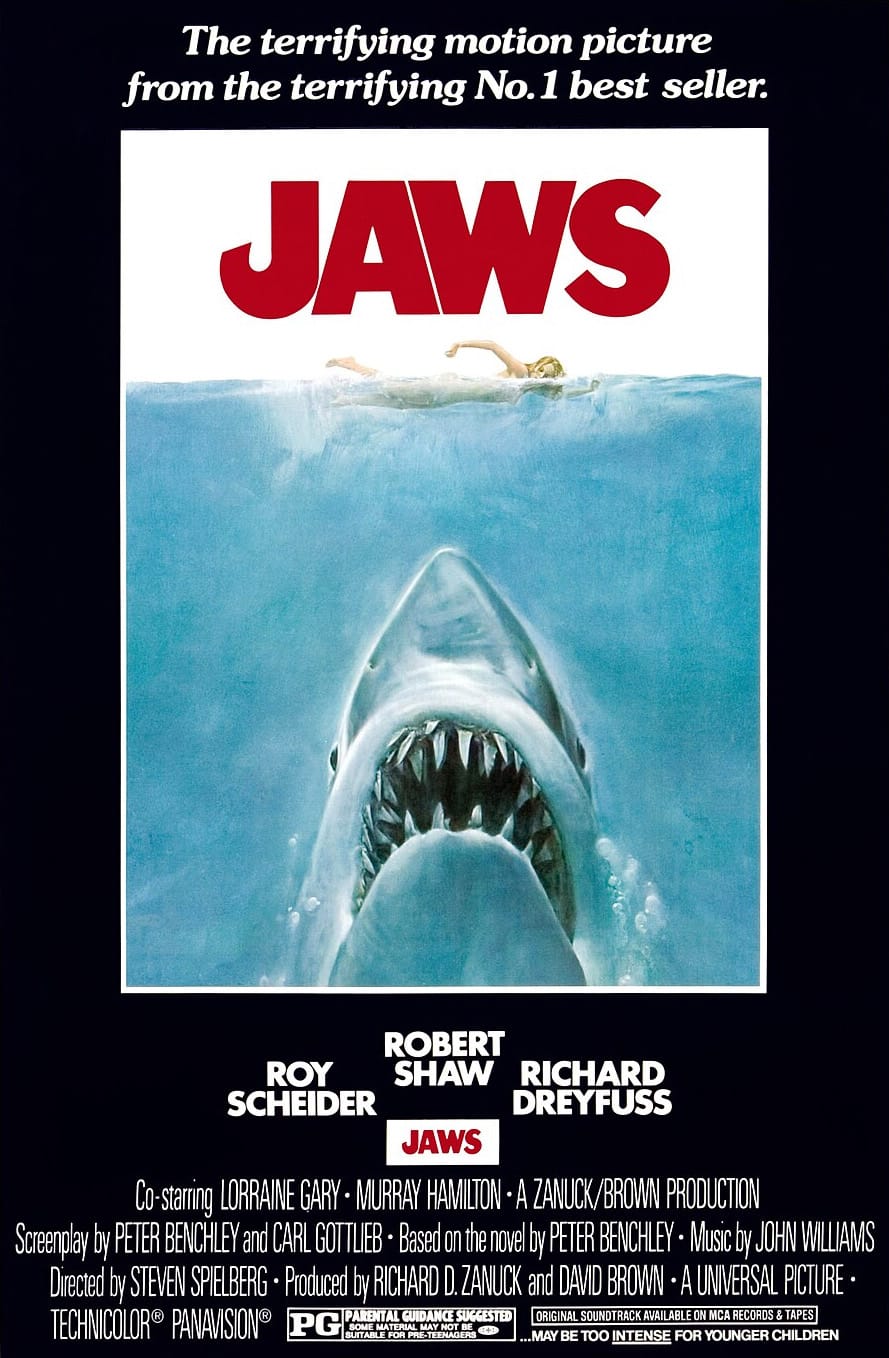
Yep. That painting, the same one that appeared on the cover of the paperback edition of the novel, is public domain.
This is kind of a wild story.
When the book first came out, it didn’t have this cover art. An old New York Times article about the book’s origin explains that the author, Peter Benchley, actually had his own idea for the cover. He thought it should show “a peaceful unsuspecting town through the bleached jaws of a shark.” He pitched his idea to Doubleday, who was publishing the hardcover version of the book.
So Doubleday senior editor Tom Congdon worked with art director Alex Gotfryd and had an artist produce this mock-up:

Congdon didn’t like it. He said, “the shark’s bones look too liplike and pendulous.” A preview of the cover was shown at a book sales manager’s conference, and there was “considerable resistance” from the salesmen who said it resembled a vagina with teeth.
The book was supposed to come out in January, 1974, but publication was delayed until February to rework the cover.
Congdon asked, “Can we have just a fish on the cover?”
But Gotfryd said no. “The cover’s not big enough. It will look like a sardine.”
So they settled on no image at all. The first printed cover was just black:
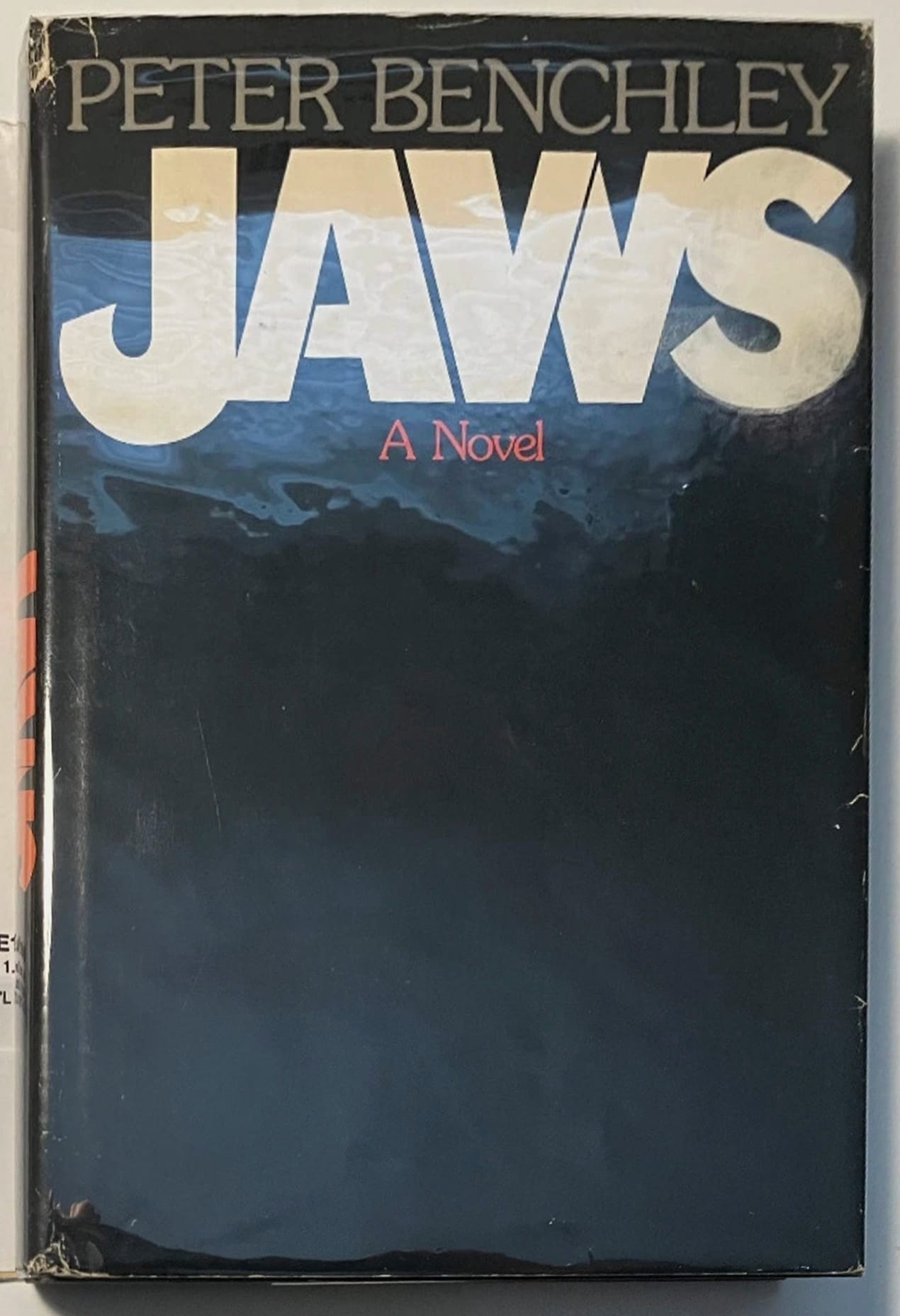
Bantam had purchased the paperback rights to the book, but when Bantam president Oscar Dystal saw the empty cover, he didn’t like it. He said, “Without an image, no one would know what Jaws was. It could have been a book about dentistry.” It needed a shark.
So Gotfryd contacted an artist named Paul Bacon who made a rough sketch of the shark’s head, and at Gotfryd’s suggestion added a swimmer for scale. The next day, Bacon came back with the finished artwork that became the new hardcover dust jacket:

Congdon later said, “We realized that the new version looked like a penis with teeth. But was that bad?”
Has any other design project ever gone from “we can’t use that because it looks like a vagina with teeth” to “that looks like a penis with teeth but let’s go with it?”
A year later, when Bantam was preparing to publish the paperback edition, they hired artist Roger Kastel to make an updated version of the cover. He went to the Museum of Natural History to study sharks, and he had a model pose across a couple of stools for reference of what someone looks like swimming. He used those elements in creating the now-famous illustration:
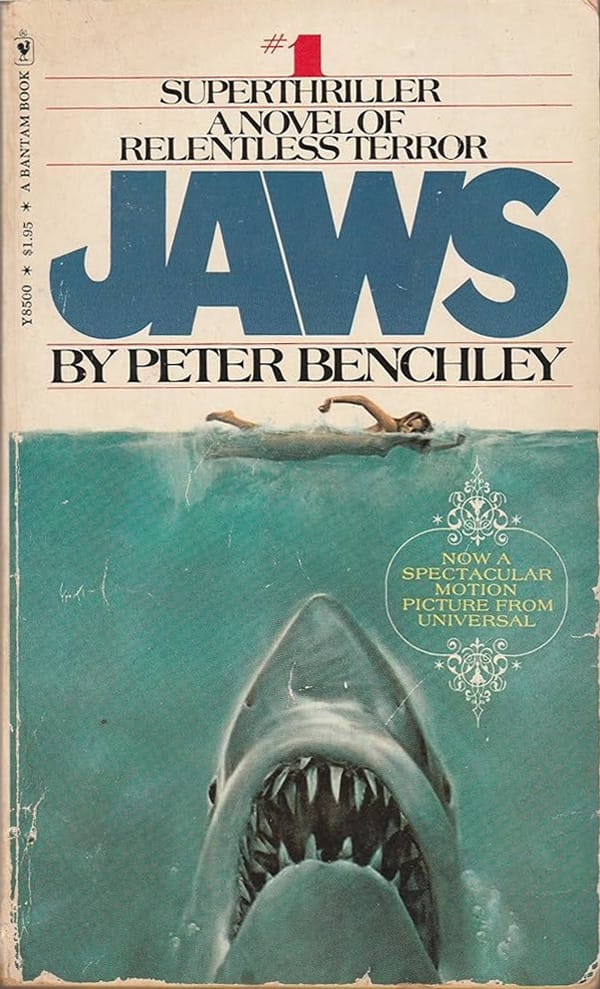
There are slightly different accounts of how Universal acquired permission to use the illustration on the movie poster. Kastel’s official website says that “Universal Studios, so impressed by the work, purchased the right to use this image as the poster for the movie.”
But a 2012 article in Empire says that Universal actually got the rights from Bantam for free:
Impressed by the cover, Universal purloined Kastel’s work for the movie poster — Bantam books chief Oscar Dystel gave it to the filmmakers for free, losing out on millions of dollars — and it quickly became iconic.
Whether Universal paid for the rights or not, Kastel became bitter about all the places it was showing up.
In 2015, he told the New York Post, “What really bothered me was that they used the image for merchandising. You see that poster on everything.” And in 2020, Kastel told writer Michael P. Coleman, “We were floored by how they merchandised that image, from t-shirts to cartoons.”
It’s unclear when exactly Kastel realized that there was something fishy about the painting’s copyright situation. I can only speculate that at some point he wondered if he was entitled to some of the money from all the licensing, and discovered that the copyright to the image had never been properly established.
See, when he made the painting in 1975, copyright was still ruled by a 1909 law that said you had to include a copyright notice upon publication of a work, and that notice had to include your name. When the book was published, it carried no such notice for the artwork. It only had a copyright notice for the text. That meant that the painting became public domain as soon as it was published.
In a bit of timing bad luck, a new copyright law enacted just a year after the book came out eliminated the notice requirement.
So in early 2013, almost 40 years after Jaws was published, Kastel filed a copyright application for the Jaws illustration. But the copyright office denied it.
He filed an appeal. They denied that, too.
In 2014, he submitted a final appeal to the Copyright Office Review Board, and the decision from the board is available to read online. The main points are:
- The image was published without a proper copyright notice, so it became public domain under the law at the time.
- The fact that the book said “Copyright © 1974 Peter Benchley” isn’t good enough to let the public know that the cover is copyrighted because that’s not the name of the cover art’s copyright owner.
- This situation is not like magazines and anthologies, which are collective works with multiple contributors that can be covered by a single copyright notice. One illustration on the cover of a novel doesn’t make it a collective work.
- If Benchley had licensed the artwork from Kastel or had some other legal relationship, that might make a difference. But he didn’t, so the works are unrelated and require separate notices.
So the review board unambiguously rejected the claim:
The Board has concluded that the copyright notice in the Book, which includes only Peter Benchley’s name, does not meet the statutory notice requirement under the 1909 Act and, as such, the Work was forfeited to the public domain upon its publication.
So whether Universal paid anything for permission to use the artwork becomes a moot point because it turns out that they didn’t need permission. And anyone could have sold merchandise with the image without paying any licensing fees to Universal, Bantam, or Kastel.
Kastel died in 2023 and, while he didn’t see any Jaws royalties from merchandise that featured his artwork, he did get more work as a result of it, including illustrating the Gone With The Wind-inspired poster for The Empire Strikes Back.
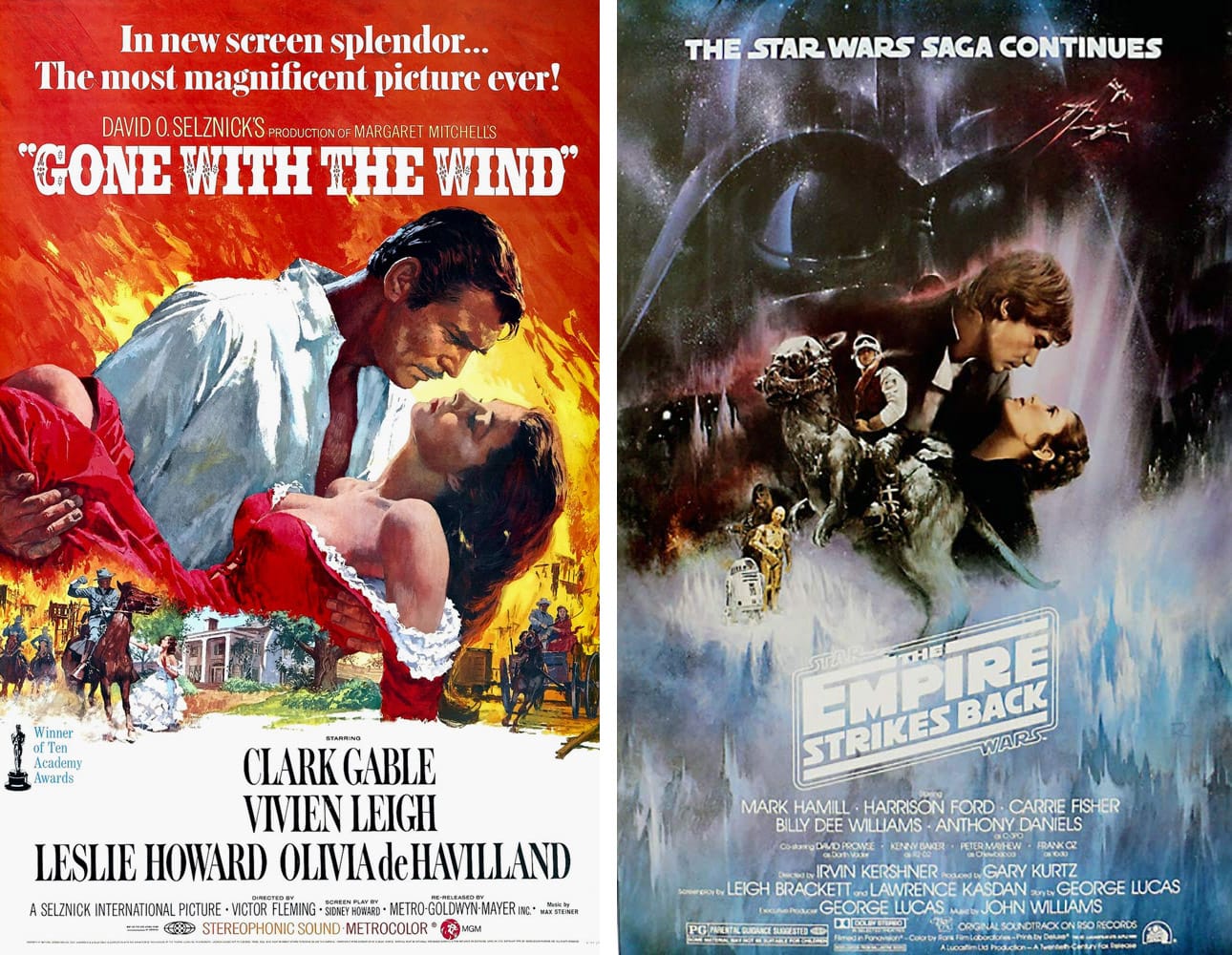
One thing that Kastel definitely did own is the original artwork used for the Jaws book cover and poster. Unfortunately, the painting went missing in 1976 and nobody knows where it is.
One story goes that the painting went on a national tour to promote the book, making stops to appear in various book store windows, and then disappeared somewhere in Hollywood. Or it may have been last seen hanging in an exhibit at the Society of Illustrators in New York.
Kastel’s son Matthew thinks it was last seen at the New York Historical Society. At least that’s what he said in an article a few years back for Daily Art Magazine but I suspect he was actually thinking of the Society of Illustrators. Either way, he wrote:
But the question remains. What happened to my father’s work?
Where is one to start on a mystery over 45 years old with no clues? Outside of putting my father’s Jaws illustration on the back of milk cartons under the caption MISSING, I have no clue.
Was the painting simply lost, misplaced, or thrown away like an old movie prop by Universal out of lack of care or ignorance? Or was it stolen somewhere in Universal’s care by an admirer and/or enterprising thief?
My recourse is limited. By writing this article, I am taking a longshot approach that someone out there reading this may know about its whereabouts or fate and step forward.
If you happen to know where the original Jaws painting is, here is where you can reach out to Matthew Kastel.
So that’s the story of how a pop culture icon became freely available for anyone to use. It’s good that creative works eventually become public domain, but I also believe an artist should be able to enjoy the fruits of his work in his lifetime if he wants to. So while I’m usually in favor of the commons, I feel like this time... it’s personal.
Fin.

What a story. I was originally inspired by a reddit post where someone noticed that Wikimedia lists the original Jaws dust jacket as public domain (the “penis with teeth” illustration). I thought that was interesting and dug deeper. As I went down that rabbit hole I learned about the situation with Kastel’s better-known paperback illustration.
If you liked this article, you can show your support by becoming a paid subscriber of this newsletter, a free subscriber if you aren’t already, or by giving a one-time tip, or just leaving a comment or reply to tell me you liked it.
And here’s a personal fun fact for people who got this far: My wedding was at the Society of Illustrators. We got married surrounded by incredible paintings by artists like J. C. Leyendecker and Norman Rockwell. As far as I recall, the Jaws poster art was not among them.
Thanks as always for reading. See you next time!
David
P.S. Have you played Gisnep lately?
P.P.S. The main sources for my research were articles in the New York Times, Print Magazine, WikiSource, the Copyright Review Board, Kastel’s official website, an interview with Kastel conducted by Michael P. Coleman, and other sites linked to throughout my piece.
